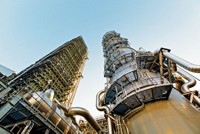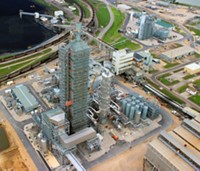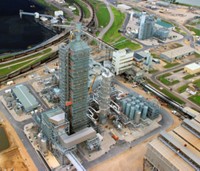Advertisement
Grab your lab coat. Let's get started
Welcome!
Welcome!
Create an account below to get 6 C&EN articles per month, receive newsletters and more - all free.
It seems this is your first time logging in online. Please enter the following information to continue.
As an ACS member you automatically get access to this site. All we need is few more details to create your reading experience.
Not you? Sign in with a different account.
Not you? Sign in with a different account.
ERROR 1
ERROR 1
ERROR 2
ERROR 2
ERROR 2
ERROR 2
ERROR 2
Password and Confirm password must match.
If you have an ACS member number, please enter it here so we can link this account to your membership. (optional)
ERROR 2
ACS values your privacy. By submitting your information, you are gaining access to C&EN and subscribing to our weekly newsletter. We use the information you provide to make your reading experience better, and we will never sell your data to third party members.
Environment
A Carbon Commodity
Advocates say enhanced oil recovery using CO2 can drive carbon capture and sequestration technologies
by Jeff Johnson
April 28, 2014
| A version of this story appeared in
Volume 92, Issue 17

At first glance, using a greenhouse gas to produce more fossil fuel appears to offer a futile and counterproductive solution to today’s climate-change crisis. But that is exactly what the Department of Energy, the oil industry, and some environmental groups are advocating.
They are touting enhanced oil recovery (EOR) as a pathway to reduce atmospheric CO2 emissions. EOR is a method used by the oil industry to produce more oil by injecting highly pressurized supercritical CO2 into partially depleted oil fields to recover oil left behind from previous drilling operations.
Oil companies have found that about half of the CO2 used in the EOR process stays underground, geologically entombed in pores that originally held oil. Consequently, EOR is being considered as a sequestration technology for CO2, the most common and pervasive anthropogenic greenhouse gas.
But EOR is not a magic bullet. Even if as much as half of the CO2 used in EOR stays underground, the gas can leak back to the surface when pockets are disturbed. Also, and perhaps most important, EOR yields more oil, the combustion of which generates more CO2.
Because EOR increases oil production, the oil industry’s use of the method is expected to grow, according to industry and DOE analysts. That growth should fuel demand for CO2, potentially creating a lucrative market for the gas, which could help kick-start stalled commercial development of technologies needed to capture CO2 from large industrial sources, particularly coal- and natural-gas-fired power plants.
EOR could become the “technology bridge” to deployment of cost-effective plant-scale carbon capture, said Julio Friedmann, DOE deputy assistant secretary for clean coal, earlier this year when testifying at a House of Representatives Energy & Commerce Committee hearing. Many House members listened closely, particularly those from coal states who are trying to block a new Environmental Protection Agency proposal to cap CO2 emissions from new power plants. For coal-fired plants, those CO2 emissions levels could be achieved only with carbon capture and sequestration (CCS) technologies.
EPA says in its proposal that its carbon emissions limit was based on projections for three U.S. and one Canadian coal-fired power plant that are now under development. Critics in Congress and industry have complained that the agency should not base limits on unproven technologies.
These four power plants would all use carbon capture technologies that would be set up to feed CO2 to EOR operations, Friedmann noted, saying that approach is the “most near-term and most commercially attractive utilization option for captured CO2.”
Friedmann acknowledged that electricity generated by power plants using CCS technologies would be 80% more expensive than the electricity from the current fleet of coal-fired power plants as well as from natural-gas-fired plants. For him, revenue from selling the captured CO2 for oil recovery could offset the high cost for early adopters of expensive CCS technologies.
His views are echoed by Bruce Hill, chief geoscientist with Clean Air Task Force, an environmental nonprofit group working to reduce greenhouse gas emissions. “Today, we have no carbon cap-and-trade program, no price on carbon, and no driver that might lead to commercial CO2 capture development,” he tells C&EN. “That is why I am bullish on EOR.”
The oil produced through EOR applications, he says, “is going to be produced anyway. We want to see capture and sequestration grow. We can start with EOR.”
Over the past half-dozen years, DOE has poured more than $6 billion into CCS projects, according to the Congressional Research Service. Small demonstration projects and a few small-scale industrial applications are just getting under way; none of the larger coal-based power plants are in commercial operation.
The furthest-along DOE-supported project is Southern Co.’s Kemper gasification facility in Mississippi, which may fire up later this year. Kemper will generate 582 MW of electricity and produce 3 million metric tons of CO2 annually for EOR applications. However, the $5 billion facility has been delayed and is over budget, and Southern has expressed doubts that it could serve as a model for CCS application.
Currently, 113 EOR projects are operating in the U.S. Some 3.1 billion cu ft of CO2 is used daily in the process, which works out to 60 million metric tons per year. About 84% of this CO2 comes from natural underground sources, according to a report by industry analysts with Advanced Resources International and DOE’s National Energy Technology Laboratory (NETL). The rest was captured at some eight U.S. industrial plants and natural gas treatment and processing facilities, which remove CO2 from the natural gas stream.
The Advanced Resources International/NETL study says the 16% share from gas processing plants and industrial sources is expected to grow to 47% by 2020. Much of the new CO2 is likely to come from industrial sites along the Gulf of Mexico coast, where it will also be injected underground, likely in depleted oil fields.

Credit: Shutterstock/C&EN
“The potential for CO2 use in EOR is huge,” says Joseph P. (Phil) DiPietro, an NETL engineer. “The 60 million metric tons used today produces about 300,000 barrels of crude oil daily. That works out to 4% of total U.S. oil production,” he explains. “We predict it could double to 600,000 bbl per day and more than 120 million tons of CO2 by 2020. About half that CO2 would come from industrial processes.”
DiPietro says oil production from EOR has the potential to grow further. “I can say with a straight face that we could get to 2 million to 3 million bbl a day of oil production using EOR, and that would draw 500 million metric tons a year in CO2 demand.”
The use of EOR began in the 1970s as an oil industry niche technology using naturally occurring CO2 to recover more oil. Most of the action has been in the Permian Basin formation of Texas and Oklahoma. Applications now run down the center of North America with an infrastructure that includes some 350 miles of CO2 pipelines.
DiPietro sees CO2 from industrial sources doubling over the next 10 years, while oil industry demand for CO2 increases and natural sources tap out. “That is where DOE’s technology development work with the coal-fired power plants comes in,” he says. “It may take 10 to 20 years to develop these coal CCS technologies, but it will also take the oil industry 10 or 20 years to run out of inexpensive CO2.” When that happens, he says, CO2 capture technologies for coal-fired power plants will be ready to compete.
To sustain this CO2 demand for EOR, oil prices have to remain high, making CCS advocates really just hopeful interlopers on an oil industry cash cow, explains former oilman Jeffrey N. Phillips. Phillips is now a senior program manager in the advanced coal group for the Electric Power Research Institute, a utility-funded research organization.
“You may get 25–30% of potentially available oil in a first drilling,” Phillips explains. “In the past, the next step was to use a ‘waterflood,’ pumping water down one hole and trying to force oil and water out another one.”
Because water and oil don’t mix, he notes, water tends to slide by without collecting too much oil. Instead, the oil industry began exploring the possibility of shifting from water to CO2.
When CO2 is used, it mixes and dissolves into oil and, at 2,000 psi, the gas expands into oil making it less viscous, Phillips says.
“With pressurized CO2, drillers are getting 50% of the reserve,” he says. When the high-pressure CO2-oil mixture comes to the surface, it depressurizes and the oil and CO2 separate. “It is like opening a can of Coke,” Phillips explains. “The CO2 just bubbles out of the oil.”
Oil producers using CO2 then tried to recapture the gas and repressurize it for use in other holes, Phillips says. They found that roughly half the CO2 stayed underground, trapped in geologic pores. So EOR began to be examined as a storage mechanism.
But sometimes CO2 doesn’t stay contained underground.
In August 2011, a CO2 release occurred in an EOR operation run by Denbury Resources, an oil producer, in Yazoo County, Miss. The release lasted 37 days and suffocated wildlife. It was caused by an inadequately capped old well bore, according to a report from the Mississippi Commission on Environmental Quality. As Denbury cleaned up CO2, water, and oil at the leak site, it also plugged 30 other old wells in the oil field, according to the state report. The state fined Denbury $662,500. Denbury did not return C&EN’s calls and e-mails seeking comment. Other leaks have been reported in Louisiana and Wyoming.
Because of leaks, the Sierra Club is challenging a DOE-supported proposed project in Kern County, Calif.—the Hydrogen Energy California gasification facility. It would use coal and petroleum coke to generate hydrogen, fertilizer, and 300 MW of electricity while capturing and selling 3 million metric tons of CO2 per year for EOR.
In a letter to the California Energy Commission, Sierra Club attorney Andrea Issod cited the Mississippi and Louisiana leaks, pointing to documents showing that more than 1,000 old wells penetrate the oil and gas reservoir where EOR is being proposed in California. Issod wants a thorough examination of all abandoned and capped wells at the proposed injection site, looking at age, well integrity, and accuracy of well records before EOR begins.
What this examination reveals, as well as what occurs when the Kemper facility begins operating later this year, may determine whether EOR will become part of a climate-change solution or be part of the fossil-fuel problem.





Join the conversation
Contact the reporter
Submit a Letter to the Editor for publication
Engage with us on Twitter